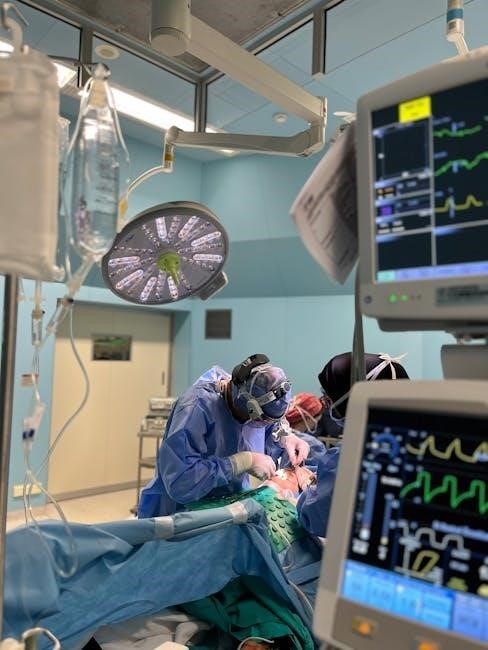Anesthesia is a critical medical practice enabling pain-free surgery by preventing nerve signals from reaching the brain. It ensures patient comfort and is essential for modern surgical success.
Definition and Purpose of Anesthesia

Anesthesia is a medical practice that prevents pain during surgical procedures by temporarily numbing sensation or inducing unconsciousness. Its primary purpose is to ensure patient comfort, allowing surgeries to be performed without pain or distress. Anesthesia can be administered in various forms, including general, regional, local, or sedation, depending on the procedure and patient needs. By blocking pain signals to the brain, anesthesia enables surgeons to perform complex operations while maintaining patient safety and reducing stress. This practice is fundamental to modern surgery, as it allows for precise and efficient procedures. Anesthesia also minimizes physiological responses to surgical stress, contributing to better postoperative recovery. Overall, its role is critical in enhancing surgical outcomes and improving patient care.
Historical Development of Anesthesia
The introduction of anesthesia in 1846 revolutionized surgery by eliminating pain during procedures. A Boston dentist demonstrated ether anesthesia, marking the beginning of modern anesthetic practices. This breakthrough enabled pain-free surgeries, transforming medical care. Over time, safer anesthetic agents like chloroform and nitrous oxide were introduced, improving patient safety. The 20th century saw advancements in synthetic opioids and precise delivery systems, enhancing anesthesia’s effectiveness. Historical developments have led to the refined techniques and medications used today, ensuring patient comfort and minimizing risks during surgical procedures. This evolution underscores anesthesia’s critical role in advancing surgical medicine and improving patient outcomes.
Importance of Anesthesia in Modern Surgery

Anesthesia is a cornerstone of modern surgery, enabling pain-free procedures and significantly improving patient outcomes. It allows surgeons to perform complex operations without patient discomfort or movement. By preventing pain perception and controlling autonomic reflexes, anesthesia ensures a controlled surgical environment. Modern anesthesia also minimizes stress responses, reducing the risk of complications. The development of various anesthetic types—general, regional, local, and sedation—provides tailored approaches for different procedures and patient needs. Advances in anesthetic agents and monitoring technologies have enhanced safety, making surgery more accessible and effective. Anesthesia also facilitates faster recovery, as patients experience less trauma and pain during procedures. Its role in modern medicine is indispensable, enabling life-saving and elective surgeries while prioritizing patient comfort and safety.
Types of Anesthesia Used in Surgical Procedures
Anesthesia is categorized into four main types: general, regional, local, and sedation. Each type is tailored to specific procedures and patient needs, ensuring optimal pain management and comfort;
General Anesthesia
General anesthesia induces a sleep-like state, rendering patients unconscious and unresponsive to pain. It is commonly used for major surgeries requiring deep relaxation and when local or regional anesthesia is insufficient. Achieved through intravenous medications and inhaled gases, it prevents pain perception and reflexes. Indications include surgeries with significant blood loss, compromised breathing, or uncooperative patients. Relative contraindications include unoptimized medical conditions or difficult airways. The process involves induction, often with propofol, followed by maintenance with volatile anesthetics. Patients are closely monitored to ensure safety and comfort throughout the procedure.
Regional Anesthesia
Regional anesthesia numbs a specific area of the body, blocking nerve signals to prevent pain during surgery. It is commonly used in procedures like childbirth, orthopedic surgeries, and general surgery. Techniques include epidural, spinal, and peripheral nerve blocks. Epidural anesthesia injects anesthetic near the spinal sac, providing pain relief during labor or surgeries like cesarean sections. Spinal anesthesia involves injecting a single dose into the spinal fluid, offering rapid numbing for lower body procedures. Peripheral nerve blocks target specific nerves, often used in limb surgeries. Regional anesthesia reduces the need for systemic painkillers, minimizes side effects, and allows patients to remain awake or lightly sedated. Risks include allergic reactions, nerve damage, or infection, but these are rare. It is favored for its effectiveness in postoperative pain management and reduced recovery time compared to general anesthesia.
Local Anesthesia
Local anesthesia involves numbing a small, specific area of the body to prevent pain during minor surgical or diagnostic procedures. It is commonly used for procedures like skin biopsies, dental work, or minor surgeries. The anesthetic is typically administered via injection or topical application, blocking nerve signals in the targeted area. This type of anesthesia allows patients to remain awake and alert, reducing the risks associated with general anesthesia. Local anesthesia is favored for its safety profile, minimal side effects, and quick recovery time. Commonly used agents include lidocaine, benzocaine, and novocaine. It is particularly beneficial for patients with medical conditions that make general anesthesia risky. However, it is less effective for complex or deep tissue procedures, where regional or general anesthesia may be more appropriate. Local anesthesia is a versatile and effective option for providing localized pain relief with minimal systemic impact.
Sedation (Monitored Anesthesia Care)
Sedation, also known as Monitored Anesthesia Care (MAC), is a technique that helps patients relax and feel drowsy during procedures without being fully unconscious. It is commonly used for minimally invasive procedures, childbirth (e.g., epidurals), and minor surgeries. Sedation is administered through intravenous (IV) medications or oral routes, allowing patients to remain responsive to commands while reducing anxiety and discomfort. This method is ideal for procedures where local or regional anesthesia alone is insufficient. Patients typically recover quickly from sedation, with minimal side effects. Sedation is often combined with local anesthesia to enhance pain relief. It is particularly useful for patients who are anxious or uncooperative but do not require the deeper effects of general anesthesia. The goal of sedation is to ensure patient comfort while maintaining safety and procedural efficiency.

Indications and Contraindications for General Anesthesia
General anesthesia is indicated for surgeries requiring deep relaxation, significant blood loss, or uncooperative patients. Contraindications include patient refusal, unstable medical conditions, and certain comorbidities like severe aortic stenosis.

Patient Selection Criteria

Patient selection for general anesthesia involves evaluating medical history, current health status, and surgical requirements. The anesthesiologist assesses factors like the need for deep relaxation, expected blood loss, and patient cooperation. Medical conditions such as unstable angina or severe pulmonary disease require optimization before elective surgery. Patients with difficult airways or significant comorbidities like aortic stenosis are carefully considered. Personal or family history of conditions like malignant hyperthermia or pseudocholinesterase deficiency necessitates special planning. The decision also considers the patient’s preference and the surgeon’s input. Preoperative evaluation ensures patients are medically optimized, balancing risks and benefits. This comprehensive assessment ensures safe and effective anesthesia administration, tailored to individual needs and surgical requirements.
Relative Contraindications
Relative contraindications for general anesthesia include unoptimized medical conditions, significant comorbidities, and procedures that could be managed with regional or local anesthesia. Conditions like severe aortic stenosis, pulmonary disease, or heart failure require careful evaluation. Patients with difficult airways or those undergoing procedures that could avoid airway manipulation are also considered high-risk. Additionally, uncooperative patients or those with a history of malignant hyperthermia or pseudocholinesterase deficiency need specialized planning. While there are no absolute contraindications except patient refusal, relative contraindications highlight the need for preoperative optimization. Surgeons and anesthesiologists collaborate to weigh risks and benefits, ensuring safe anesthesia administration. Patient-specific factors and surgical urgency further influence decision-making, emphasizing the importance of a tailored approach.
Absolute Contraindications
Absolute contraindications for general anesthesia are rare but include patient refusal and emergency situations where delaying surgery could result in severe harm or death. Patient refusal is a clear absolute contraindication, as informed consent is mandatory. In life-threatening emergencies, such as severe trauma or ruptured aneurysms, the risks of delaying surgery outweigh those of anesthesia, making immediate intervention necessary. Additionally, certain conditions like active malignant hyperthermia or uncontrolled severe hypertension may require careful consideration. However, advancements in anesthesia techniques often allow safe administration even in high-risk scenarios. The anesthesiologist plays a critical role in assessing these cases and making informed decisions to ensure patient safety while addressing urgent surgical needs.

Preoperative Evaluation for Anesthesia
Preoperative evaluation is crucial for assessing surgical risks and optimizing patient health; It involves reviewing medical history, physical exams, lab tests, and implementing strategies to ensure safe anesthesia administration.

Medical History and Physical Examination
A thorough preoperative medical history and physical examination are essential for identifying potential risks and optimizing patient care. This evaluation includes reviewing the patient’s past medical history, surgeries, allergies, and current medications. The anesthesiologist assesses the patient’s overall health, focusing on critical systems such as cardiovascular, respiratory, and neurological function. A detailed history of previous anesthetic experiences and family medical history is also collected to identify conditions like malignant hyperthermia or pseudocholinesterase deficiency. The physical examination emphasizes airway assessment, including the Mallampati classification, and evaluation of vital signs. The American Society of Anesthesiologists (ASA) Physical Status Classification is used to categorize patients based on their physical condition. This comprehensive approach ensures personalized anesthesia planning, minimizes risks, and improves surgical outcomes. It also guides the need for additional diagnostic tests or preoperative optimization strategies.
Laboratory Tests and Diagnostic Procedures
Laboratory tests and diagnostic procedures are crucial for assessing a patient’s health before anesthesia. Common tests include complete blood count, blood chemistry, coagulation studies, and urinalysis. Additional tests like chest X-rays, EKG, or pulmonary function tests may be required for high-risk patients. These evaluations help identify potential risks, such as anemia, electrolyte imbalances, or cardiac issues. Imaging studies may also be conducted to assess anatomical structures relevant to the procedure. The results guide anesthesia planning, ensuring safe administration and minimizing complications. For example, abnormal coagulation studies may prompt further evaluation or consultation with a specialist. These diagnostic steps are tailored to the patient’s medical history, physical condition, and the surgical procedure, ensuring personalized and safe anesthesia care. They also help in optimizing the patient’s health before surgery, reducing perioperative risks.
Patient Optimization Strategies
Patient optimization is critical to minimize risks and improve outcomes under anesthesia. This involves addressing medical conditions, such as optimizing blood pressure, blood sugar, or heart function, to reduce perioperative risks. Smoking cessation and alcohol avoidance are encouraged to improve respiratory and cardiovascular health. Nutritional support and hydration are emphasized to enhance recovery. Patients with chronic conditions, like asthma or diabetes, require tailored management. Medication adjustments, such as stopping blood thinners or continuing essential drugs, are coordinated with the anesthesia team. Patient education on postoperative care and pain management is also vital. Physical conditioning and stress reduction techniques may be recommended. These strategies aim to improve the patient’s overall health and readiness for surgery, ensuring a safer and more effective anesthetic experience. Clear communication between the patient, surgeon, and anesthesiologist is essential for successful optimization. Regular follow-ups and preoperative check-ups are conducted to confirm readiness. This comprehensive approach reduces complications and enhances recovery.

Equipment Required for General Anesthesia
The anesthesia machine, ventilator, gas supply, vaporizers, and breathing circuits are essential. Monitors track vital signs, while airway tools like endotracheal tubes and laryngoscopes ensure proper ventilation and patient safety.
Anesthesia Machine Components
Anesthesia machines are complex devices designed to deliver precise amounts of anesthetic gases and oxygen to patients. Key components include a gas supply system, vaporizers for volatile anesthetics, and flow meters to regulate gas flow. The machine also features a breathing circuit, which connects to the patient’s airway, and a ventilator to assist or control breathing. Monitoring systems display vital signs such as oxygen saturation, heart rate, and blood pressure. Safety features include fail-safe mechanisms to prevent gas leaks or oxygen failure. The machine is equipped with suction canisters to remove waste gases and fluids. Modern anesthesia machines integrate advanced technology, such as touch-screen interfaces and data recording capabilities, to enhance patient safety and operational efficiency. Proper functioning of these components is critical for ensuring safe and effective anesthesia administration during surgical procedures.
Airway Management Tools
Airway management tools are essential for maintaining a patient’s airway during anesthesia. These tools ensure proper ventilation and oxygenation. Key devices include endotracheal tubes, which are inserted through the mouth or nose into the trachea to secure the airway. Laryngeal mask airways (LMAs) are alternatives for less invasive procedures, sitting above the glottis to facilitate breathing. Face masks, oral and nasal airways, and bag-valve-mask (BVM) devices are used for non-invasive ventilation. Intubation aids like laryngoscopes and video laryngoscopes help visualize the airway for tube placement. Additional tools, such as stylets and bougies, assist in difficult intubations. Suction devices remove secretions, and cricothyrotomy kits are reserved for emergency airway access. Proper selection and use of these tools are critical to prevent complications like airway obstruction or hypoxia, ensuring safe anesthesia administration.
Monitoring Devices
Monitoring devices are vital for ensuring patient safety during anesthesia. They track physiological parameters such as heart rate, blood pressure, and oxygen saturation. Electrocardiograms (ECGs) monitor cardiac activity, while pulse oximeters measure oxygen levels in the blood. Capnography assesses carbon dioxide levels to confirm proper ventilation and anesthesia depth. Respiratory monitors track breathing rates and volumes. Temperature probes prevent hypothermia or hyperthermia. Blood pressure monitors, both non-invasive and invasive, provide real-time data. Depth of anesthesia monitors, like bispectral index (BIS), ensure appropriate consciousness levels. These devices enable early detection of complications, allowing timely interventions. They are integral to the anesthesia machine and connected to alarm systems to alert the anesthesiologist of any deviations from normal ranges. Accurate and continuous monitoring ensures optimal patient outcomes and safe anesthesia administration throughout the procedure.
Pharmacology of Anesthetic Agents
Anesthetic agents include IV anesthetics, inhalational agents, sedatives, opioids, and neuromuscular blockers, each with unique roles in inducing unconsciousness, analgesia, relaxation, and amnesia, balancing efficacy and side effects.
Classes of Anesthetic Agents
The five main classes of anesthetic agents include intravenous (IV) anesthetics, inhalational anesthetics, IV sedatives, synthetic opioids, and neuromuscular blocking drugs. Each class has distinct pharmacological properties and roles. IV anesthetics, such as propofol, induce rapid unconsciousness and are commonly used for induction. Inhalational anesthetics, like isoflurane, are administered via inhalation and provide both hypnosis and analgesia during maintenance. IV sedatives, such as midazolam, are used for mild relaxation and anxiolysis. Synthetic opioids, like fentanyl, offer potent analgesia without significant sedation. Neuromuscular blockers, such as rocuronium, paralyze muscles to facilitate surgical access. These agents are often combined to achieve balanced anesthesia, optimizing patient comfort and surgical conditions while minimizing side effects. Understanding their pharmacokinetics and pharmacodynamics is essential for safe and effective anesthesia management.
Mechanism of Action
Anesthetic agents work by modulating nervous system activity to block pain perception and consciousness. General anesthetics act on the central nervous system (CNS), targeting ion channels and neurotransmitter receptors like GABA and NMDA. Inhalational agents enhance inhibitory neurotransmission, while intravenous agents like propofol potentiate GABA receptor activity, inducing sedation and amnesia. Regional anesthetics, such as lidocaine, block sodium channels in peripheral nerves, preventing pain signals from reaching the CNS. Local anesthetics act similarly but are applied directly to tissues. Sedatives, like midazolam, enhance GABA activity, reducing anxiety and consciousness. Opioids bind to mu-receptors, inhibiting pain transmission. Neuromuscular blockers, such as rocuronium, inhibit acetylcholine at the neuromuscular junction, causing muscle paralysis. Each class disrupts specific pathways to achieve anesthesia, ensuring pain relief and patient immobility during surgery.
Common Side Effects and Risks
Anesthesia, while safe for most patients, carries potential side effects and risks. Common issues include nausea, vomiting, sore throat, dizziness, and temporary confusion or memory loss. More severe complications, though rare, may occur. These include allergic reactions, malignant hyperthermia (a life-threatening condition triggered by certain anesthetics), and respiratory or cardiac issues. Elderly or frail patients are at higher risk for prolonged confusion or cognitive dysfunction. Additionally, aspiration of stomach contents during general anesthesia can lead to pneumonia. The choice of anesthetic and patient health influence these risks. Preoperative evaluation and optimization reduce complications. Effective monitoring during surgery ensures timely intervention if adverse effects arise. Communication between the anesthesia team and patient is crucial to minimize risks and ensure safe outcomes.

Intraoperative Anesthesia Management
Intraoperative anesthesia management involves continuous monitoring and adjusting anesthetic levels to ensure patient safety and comfort during surgery, addressing any unexpected issues promptly and effectively.
Induction and Maintenance Techniques
Induction in general anesthesia typically begins with intravenous (IV) administration of agents like propofol, etomidate, or ketamine, inducing rapid unconsciousness. This is often combined with neuromuscular blockers to facilitate endotracheal intubation. Maintenance involves sustaining the anesthetic state, commonly using inhalational agents such as sevoflurane or isoflurane, or continuous IV infusions of propofol. The choice of technique depends on the patient’s health, procedure type, and anesthesiologist preference. Inhalational agents offer precise control, while IV maintenance provides flexibility, especially in cases with limited airway access. Both methods ensure immobility, analgesia, and amnesia throughout surgery. Proper titration of these agents is crucial to avoid complications and promote smooth recovery. Effective communication between the anesthesia team and surgeons ensures tailored approaches, optimizing patient outcomes and surgical conditions.
Intraoperative Monitoring and Adjustments
Intraoperative monitoring is essential for ensuring patient safety and optimal surgical conditions. Anesthesiologists continuously track vital signs such as heart rate, blood pressure, oxygen saturation, and end-tidal CO2 levels. Depth of anesthesia is assessed using bispectral index (BIS) monitoring to prevent awareness and excessive anesthetic depth. Adjustments are made based on surgical requirements and patient responses, such as increasing ventilation for rising CO2 levels or administering vasopressors to stabilize blood pressure. Anesthetic agents are titrated to maintain immobility and analgesia while minimizing side effects. Communication between the anesthesia and surgical teams ensures real-time adaptations, such as fluid administration or adjusting anesthetic levels during blood loss. These interventions aim to maintain homeostasis, prevent complications, and optimize recovery. Continuous vigilance and precise adjustments are critical for delivering safe and effective anesthesia care.

